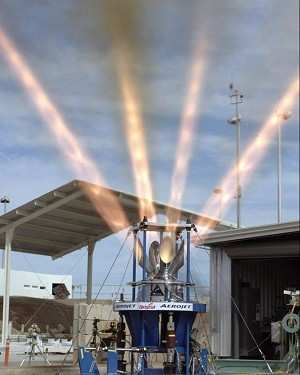Fri, Nov 21, 2008
First-Ever Ground Test Marks Historic Milestone
 Right on schedule, on Thursday a team
comprised of NASA, Lockheed Martin Corporation, Orbital Sciences
Corporation and Alliant Techsystems successfully performed a ground
firing test of the abort motor for the Orion crew exploration
vehicle Launch Abort System at ATK's Launch Systems facility in
Promontory, UT.
Right on schedule, on Thursday a team
comprised of NASA, Lockheed Martin Corporation, Orbital Sciences
Corporation and Alliant Techsystems successfully performed a ground
firing test of the abort motor for the Orion crew exploration
vehicle Launch Abort System at ATK's Launch Systems facility in
Promontory, UT.
This major milestone brings the program one step closer to
completion of the Orion spacecraft that will replace the shuttle
and provides a tremendous improvement in spaceflight safety for the
astronauts. This inaugural test of Orion's full-scale abort motor
marks the first time such a test has been conducted since the
Apollo Program tested its launch escape system in the 1960s.
Orion's abort motor has the same mission as Apollo's -- to
safely lift the Orion crew module away from the launch vehicle,
pulling the crew to safety in the event of an emergency on the
launch pad or during initial ascent phase.
The abort motor, which stands more than 17 feet tall and spans
three feet in diameter, has a manifold with four exhaust nozzles.
It was fixed into a vertical test stand with its nozzles pointing
skyward. Upon ignition, the abort motor fired for five seconds with
the exhaust plume flames reaching up to 100 feet in height. The
high-impulse motor was specifically developed so the majority of
its propellant would be expended in the first three seconds,
delivering the half million pounds of thrust needed to pull the
crew module safely away from its launch vehicle.
Unlike Apollo, Orion's abort motor utilizes a composite case,
and exhaust turn-flow technology rather than a tower, which results
in weight savings, improved performance and improved success in
crew survival during an abort. Instead of the rocket plume exiting
straight out a nozzle at the aft end, the manifold is placed at the
forward end of the motor. The rocket thrust enters the manifold and
is turned 155 degrees exiting out the four nozzles, creating a
forward-pulling force.
The next major milestone is the Pad Abort-1 Flight Test,
scheduled to take place at the White Sands Missile Range in New
Mexico next spring. A series of Launch Abort System ground and
flight tests are planned over the next several years that support
the first operational flight of Orion and Ares I scheduled for
2015.
More News
Light Gun A handheld directional light signaling device which emits a brilliant narrow beam of white, green, or red light as selected by the tower controller. The color and type of>[...]
"The journey to this achievement started nearly a decade ago when a freshly commissioned Gentry, driven by a fascination with new technologies and a desire to contribute significan>[...]
Aero Linx: JAARS, Inc. For decades now, we’ve landed planes on narrow rivers and towering mountains. We’ve outfitted boats and vehicles to reach villages that rarely se>[...]
"Our driven and innovative team of military and civilian Airmen delivers combat power daily, ensuring our nation is ready today and tomorrow." Source: General Duke Richardson, AFMC>[...]
Aircraft Conflict Predicted conflict, within EDST of two aircraft, or between aircraft and airspace. A Red alert is used for conflicts when the predicted minimum separation is 5 na>[...]
 ANN's Daily Aero-Term (04.20.24): Light Gun
ANN's Daily Aero-Term (04.20.24): Light Gun Aero-News: Quote of the Day (04.20.24)
Aero-News: Quote of the Day (04.20.24) ANN's Daily Aero-Linx (04.21.24)
ANN's Daily Aero-Linx (04.21.24) Aero-News: Quote of the Day (04.21.24)
Aero-News: Quote of the Day (04.21.24) ANN's Daily Aero-Term (04.21.24): Aircraft Conflict
ANN's Daily Aero-Term (04.21.24): Aircraft Conflict



